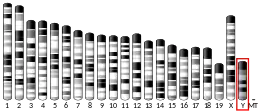| USP9Y | |||||||||||||||||||||||||||||||||||||||||||||||||||
|---|---|---|---|---|---|---|---|---|---|---|---|---|---|---|---|---|---|---|---|---|---|---|---|---|---|---|---|---|---|---|---|---|---|---|---|---|---|---|---|---|---|---|---|---|---|---|---|---|---|---|---|
| Identifiers | |||||||||||||||||||||||||||||||||||||||||||||||||||
| Aliases | USP9Y, DFFRY, SPGFY2, ubiquitin specific peptidase 9, Y-linked, ubiquitin specific peptidase 9 Y-linked | ||||||||||||||||||||||||||||||||||||||||||||||||||
| External IDs | OMIM: 400005 MGI: 1313274 HomoloGene: 68408 GeneCards: USP9Y | ||||||||||||||||||||||||||||||||||||||||||||||||||
| |||||||||||||||||||||||||||||||||||||||||||||||||||
| |||||||||||||||||||||||||||||||||||||||||||||||||||
| |||||||||||||||||||||||||||||||||||||||||||||||||||
| |||||||||||||||||||||||||||||||||||||||||||||||||||
| |||||||||||||||||||||||||||||||||||||||||||||||||||
| Wikidata | |||||||||||||||||||||||||||||||||||||||||||||||||||
| |||||||||||||||||||||||||||||||||||||||||||||||||||
Ubiquitin specific peptidase 9, Y-linked (fat facets-like, Drosophila), also known as USP9Y, is an enzyme which in humans is encoded by the USP9Y gene.[5] It is required for sperm production. This enzyme is a member of the peptidase C19 family and is similar to ubiquitin-specific proteases, which cleave the ubiquitin moiety from ubiquitin-fused precursors and ubiquitinylated proteins.
Clinical significance
Mutations in this gene have been associated with Sertoli cell-only syndrome (SCO) and male infertility.[5]
The USP9Y gene is found on the azoospermia factor (AZF) region on the Y chromosome. Men who have impaired or no sperm production often have a deletion in the AZF region, especially in the USP9Y gene, and it was thought that USP9Y was necessary for sperm production. However, a man and his father with a USP9Y deletion who could produce sperm were recently reported. The corresponding gene is present but inactive in chimpanzees and bonobos.[6][7]
References
- 1 2 3 GRCh38: Ensembl release 89: ENSG00000114374 - Ensembl, May 2017
- 1 2 3 GRCm38: Ensembl release 89: ENSMUSG00000069044 - Ensembl, May 2017
- ↑ "Human PubMed Reference:". National Center for Biotechnology Information, U.S. National Library of Medicine.
- ↑ "Mouse PubMed Reference:". National Center for Biotechnology Information, U.S. National Library of Medicine.
- 1 2 "Entrez Gene: USP9Y ubiquitin specific peptidase 9, Y-linked (fat facets-like, Drosophila)".
- ↑ Luddi A, Margollicci M, Gambera L, Serafini F, Cioni M, De Leo V, Balestri P, Piomboni P (February 2009). "Spermatogenesis in a man with complete deletion of USP9Y". N. Engl. J. Med. 360 (9): 881–5. doi:10.1056/NEJMoa0806218. PMID 19246359.
- ↑ Tyler-Smith C, Krausz C (February 2009). "The Will-o'-the-Wisp of Genetics—Hunting for the Azoospermia Factor Gene". N. Engl. J. Med. 360 (9): 925–7. doi:10.1056/NEJMe0900301. PMC 2700876. PMID 19246366.
Further reading
- D'Andrea A, Pellman D (1999). "Deubiquitinating enzymes: a new class of biological regulators". Crit. Rev. Biochem. Mol. Biol. 33 (5): 337–52. doi:10.1080/10409239891204251. PMID 9827704.
- Mesco ER, Timiras PS (1992). "Tau-ubiquitin protein conjugates in a human cell line". Mech. Ageing Dev. 61 (1): 1–9. doi:10.1016/0047-6374(91)90002-H. PMID 1723470. S2CID 13104021.
- Vogt PH, Edelmann A, Kirsch S, et al. (1997). "Human Y chromosome azoospermia factors (AZF) mapped to different subregions in Yq11". Hum. Mol. Genet. 5 (7): 933–43. doi:10.1093/hmg/5.7.933. PMID 8817327.
- Jones MH, Furlong RA, Burkin H, et al. (1997). "The Drosophila developmental gene fat facets has a human homologue in Xp11.4 which escapes X-inactivation and has related sequences on Yq11.2". Hum. Mol. Genet. 5 (11): 1695–701. doi:10.1093/hmg/5.11.1695. PMID 8922996.
- Lahn BT, Page DC (1997). "Functional coherence of the human Y chromosome". Science. 278 (5338): 675–80. Bibcode:1997Sci...278..675L. doi:10.1126/science.278.5338.675. PMID 9381176.
- Brown GM, Furlong RA, Sargent CA, et al. (1998). "Characterisation of the coding sequence and fine mapping of the human DFFRY gene and comparative expression analysis and mapping to the Sxrb interval of the mouse Y chromosome of the Dffry gene". Hum. Mol. Genet. 7 (1): 97–107. doi:10.1093/hmg/7.1.97. PMID 9384609.
- Sanger Centre, The; Washington University Genome Sequencing Cente, The (1999). "Toward a complete human genome sequence". Genome Res. 8 (11): 1097–108. doi:10.1101/gr.8.11.1097. PMID 9847074.
- Sun C, Skaletsky H, Birren B, et al. (1999). "An azoospermic man with a de novo point mutation in the Y-chromosomal gene USP9Y". Nat. Genet. 23 (4): 429–32. doi:10.1038/70539. PMID 10581029. S2CID 12286008.
- Foresta C, Ferlin A, Moro E (2000). "Deletion and expression analysis of AZFa genes on the human Y chromosome revealed a major role for DBY in male infertility". Hum. Mol. Genet. 9 (8): 1161–9. doi:10.1093/hmg/9.8.1161. PMID 10767340.
- Friel A, Houghton JA, Glennon M, et al. (2002). "A preliminary report on the implication of RT-PCR detection of DAZ, RBMY1, USP9Y and Protamine-2 mRNA in testicular biopsy samples from azoospermic men". Int. J. Androl. 25 (1): 59–64. doi:10.1046/j.1365-2605.2002.00326.x. PMID 11869379.
- Ioulianos A, Sismani C, Fourouclas N, et al. (2002). "A nation-based population screening for azoospermia factor deletions in Greek-Cypriot patients with severe spermatogenic failure and normal fertile controls, using a specific study and experimental design". Int. J. Androl. 25 (3): 153–8. doi:10.1046/j.1365-2605.2002.00340.x. PMID 12031043.
- Dada R, Gupta NP, Kucheria K (2003). "Cryptorchidism and AZF microdeletion". Asian J. Androl. 4 (2): 148. PMID 12085107.
- Dada R, Gupta NP, Kucheria K (2003). "AZF microdeletions associated with idiopathic and non-idiopathic cases with cryptorchidism and varicocele". Asian J. Androl. 4 (4): 259–63. PMID 12508125.
- Richard SM, Knuutila S, Peltomäki P, et al. (2003). "Y chromosome instability in lymphoproliferative disorders". Mutat. Res. 525 (1–2): 103–7. doi:10.1016/S0027-5107(03)00007-1. PMID 12650910.
- Raicu F, Popa L, Apostol P, et al. (2003). "Screening for microdeletions in human Y chromosome--AZF candidate genes and male infertility". J. Cell. Mol. Med. 7 (1): 43–8. doi:10.1111/j.1582-4934.2003.tb00201.x. PMC 6740091. PMID 12767260.
- Skaletsky H, Kuroda-Kawaguchi T, Minx PJ, et al. (2003). "The male-specific region of the human Y chromosome is a mosaic of discrete sequence classes". Nature. 423 (6942): 825–37. Bibcode:2003Natur.423..825S. doi:10.1038/nature01722. PMID 12815422.
- Hopps CV, Mielnik A, Goldstein M, et al. (2004). "Detection of sperm in men with Y chromosome microdeletions of the AZFa, AZFb and AZFc regions". Hum. Reprod. 18 (8): 1660–5. doi:10.1093/humrep/deg348. PMID 12871878.
- Lee KH, Song GJ, Kang IS, et al. (2005). "Ubiquitin-specific protease activity of USP9Y, a male infertility gene on the Y chromosome". Reprod. Fertil. Dev. 15 (1–2): 129–33. doi:10.1071/RD03002. PMID 12895410.
- Frydelund-Larsen L, Vogt PH, Leffers H, et al. (2004). "No AZF deletion in 160 patients with testicular germ cell neoplasia". Mol. Hum. Reprod. 9 (9): 517–21. doi:10.1093/molehr/gag069. PMID 12900510.




